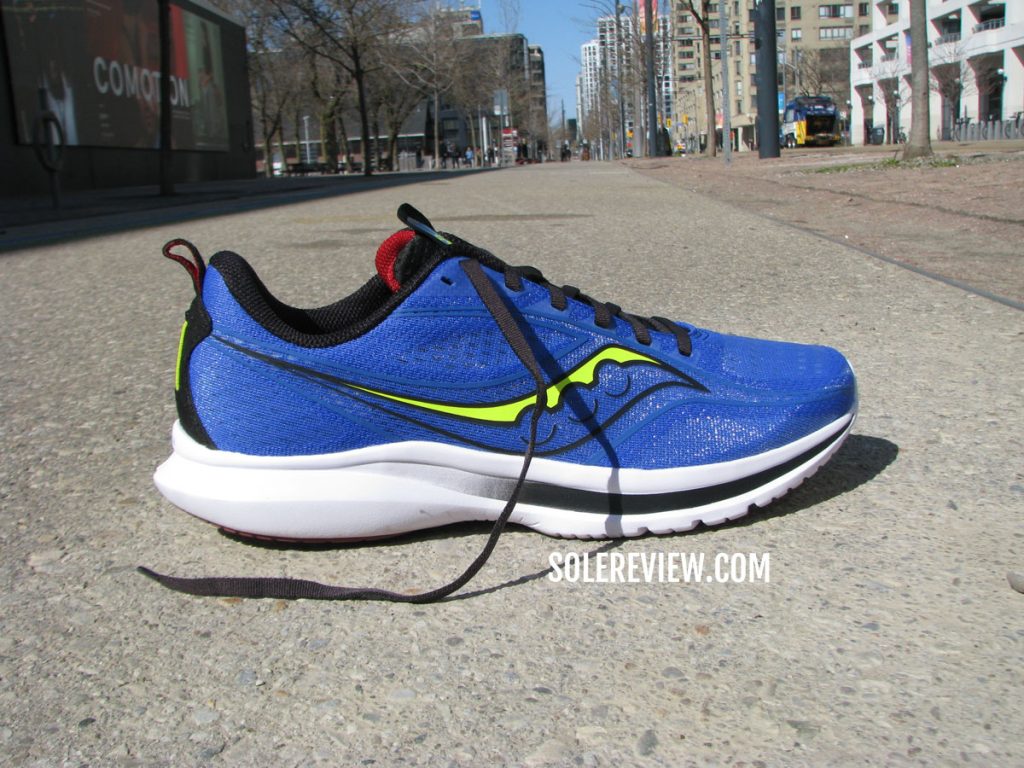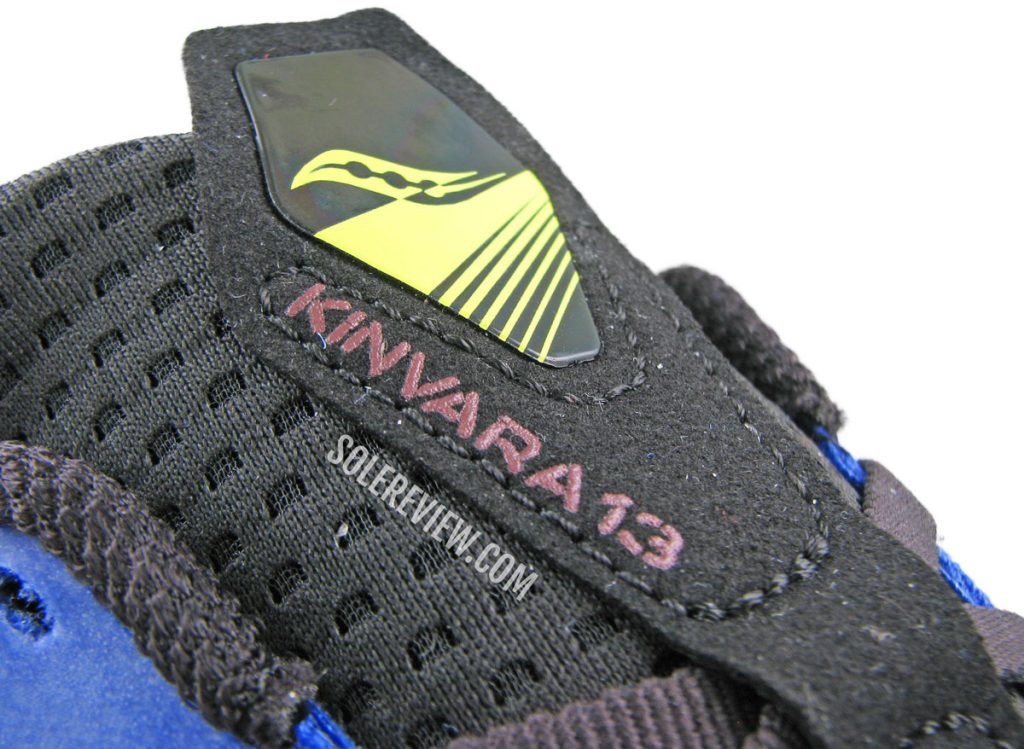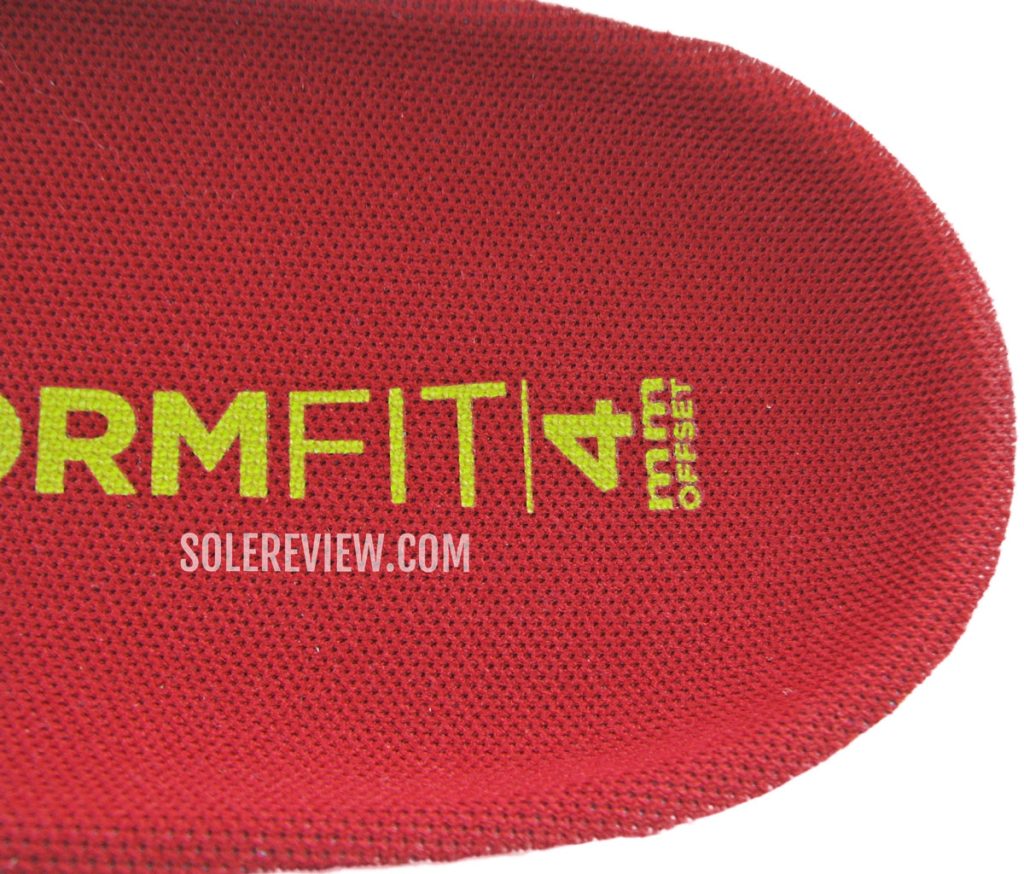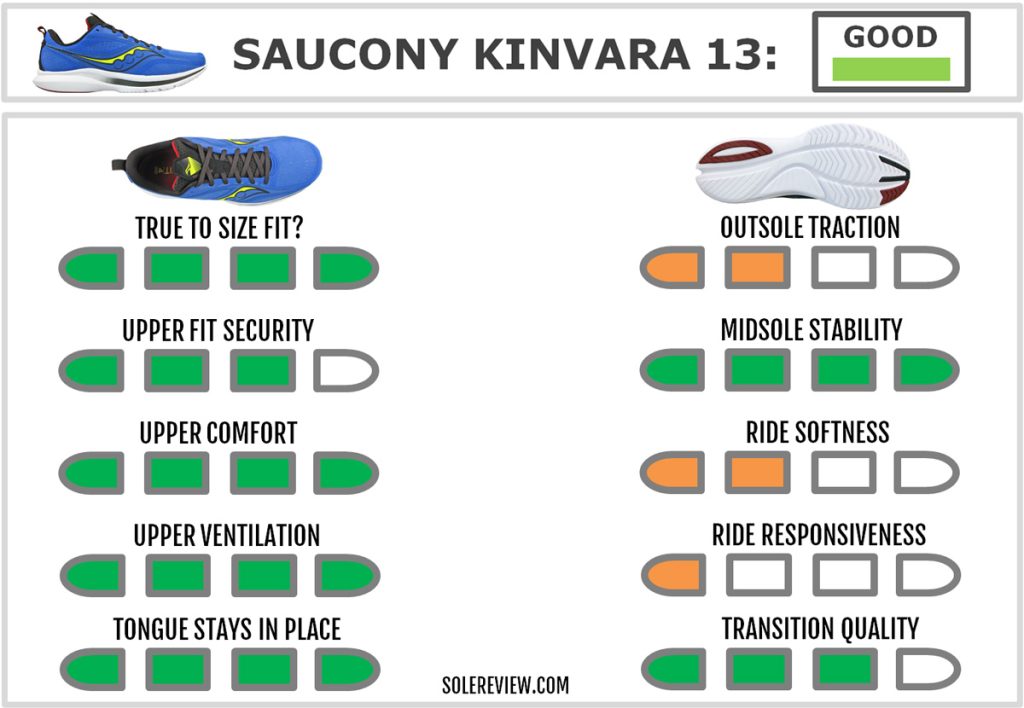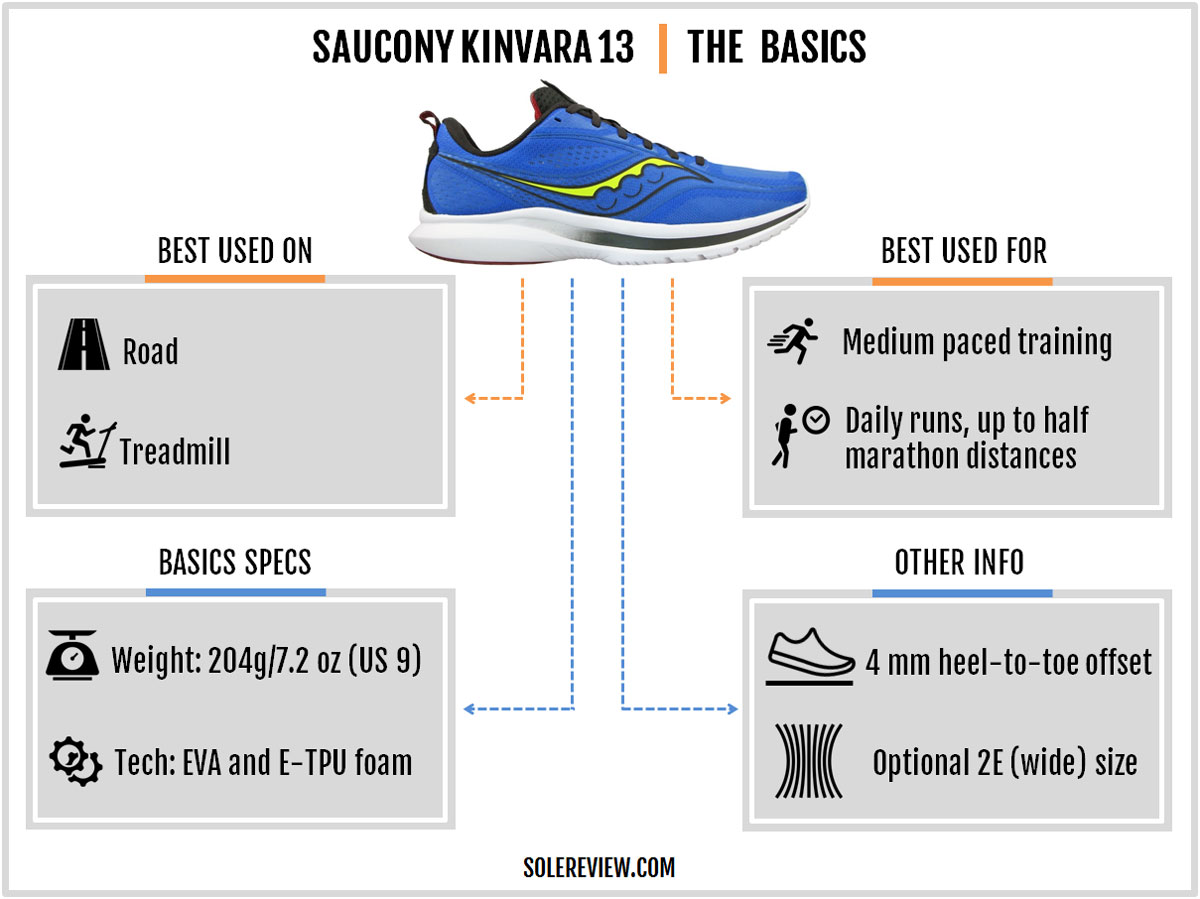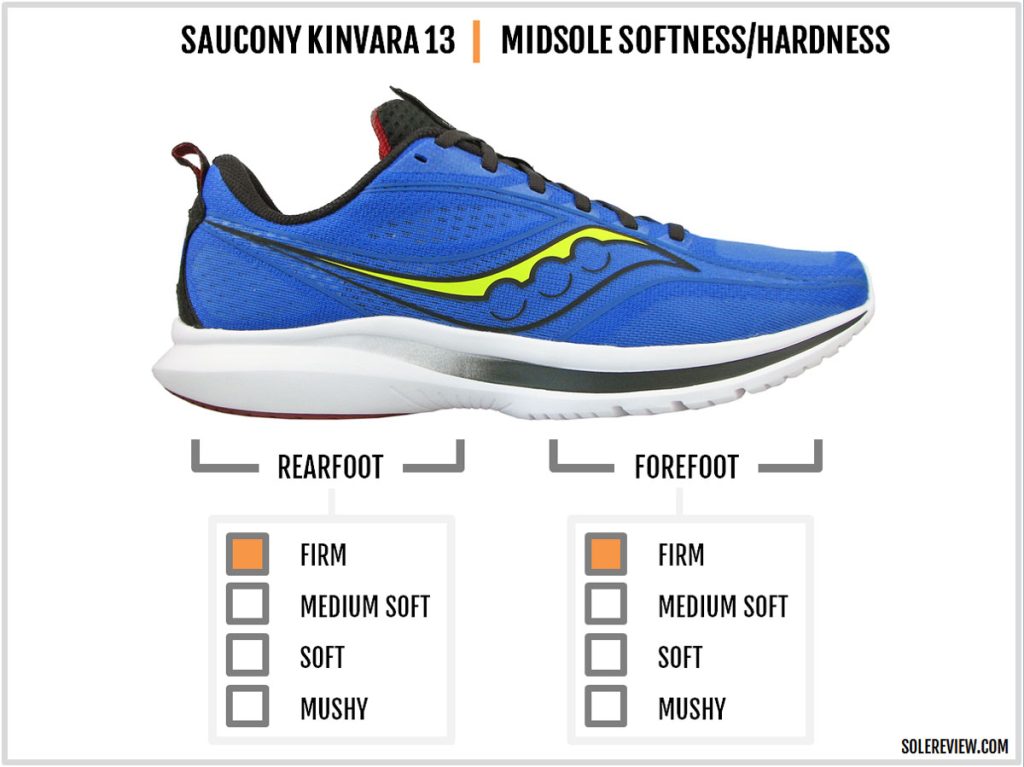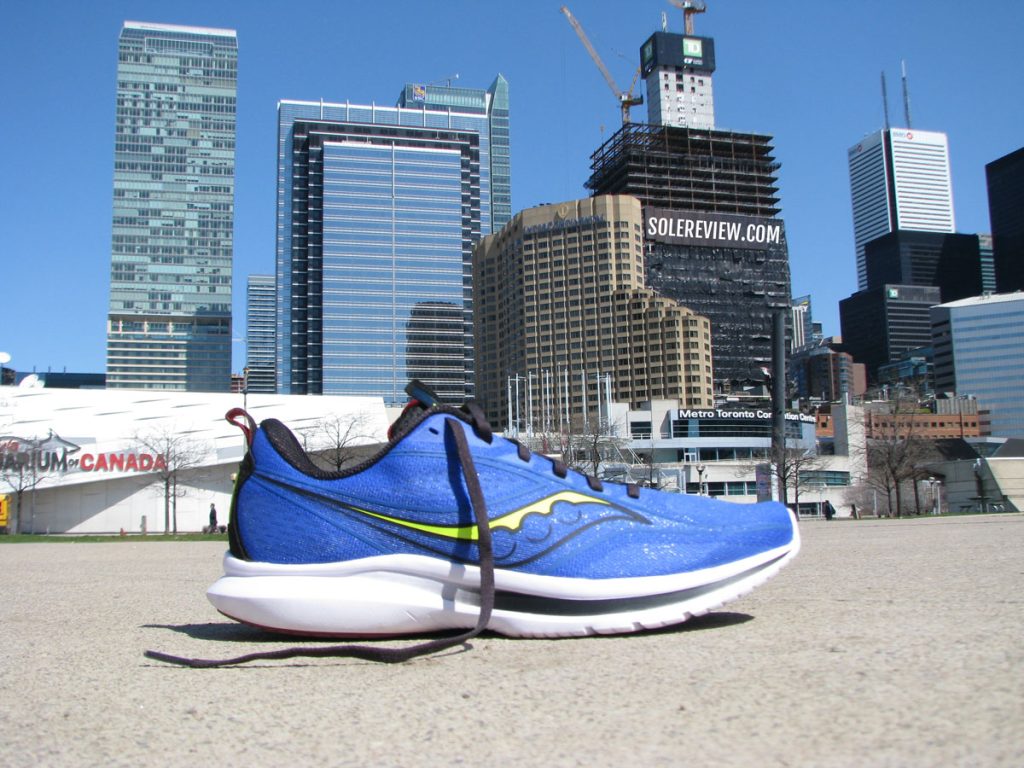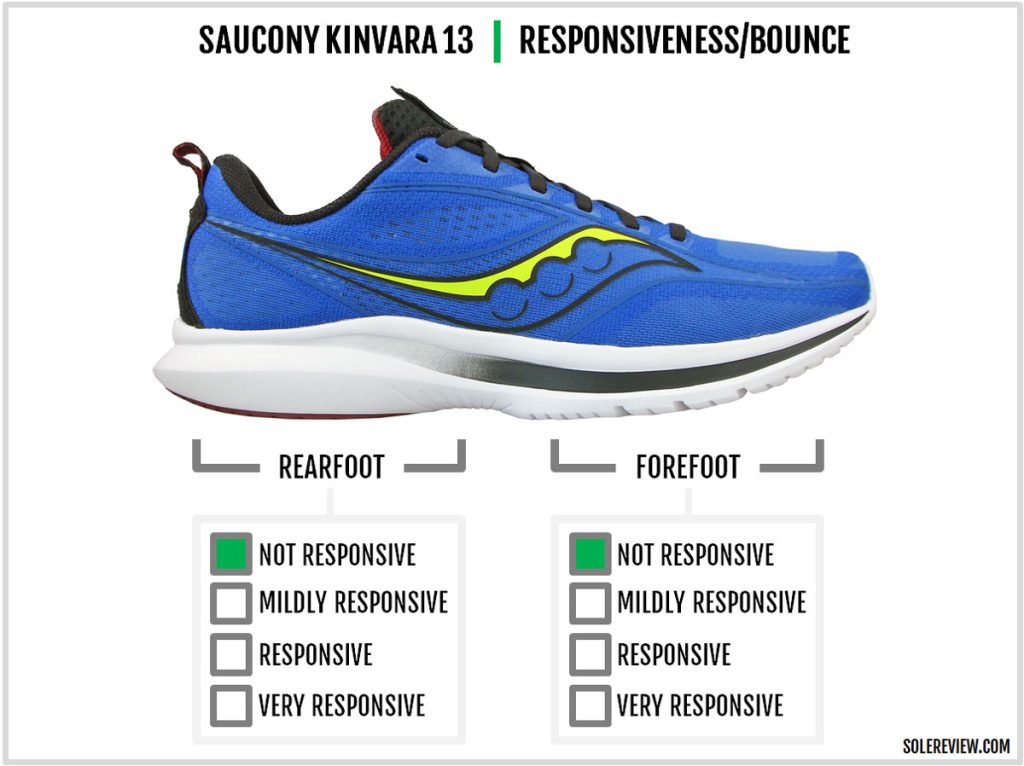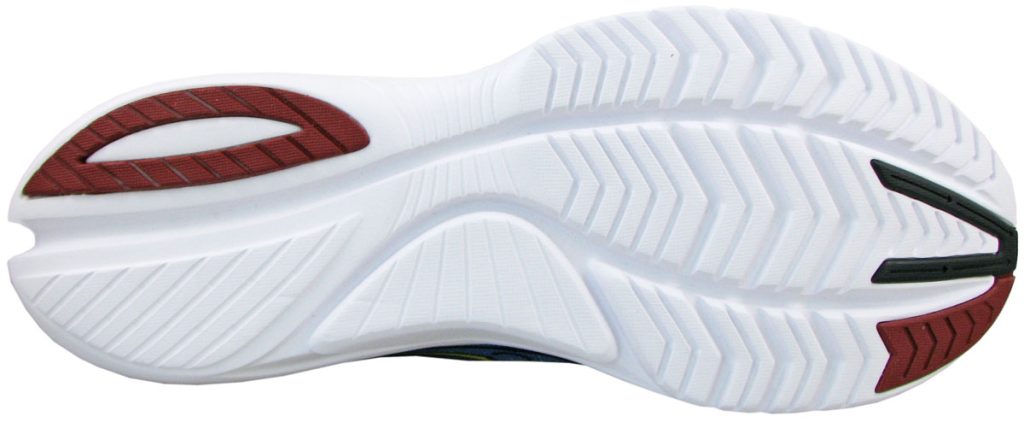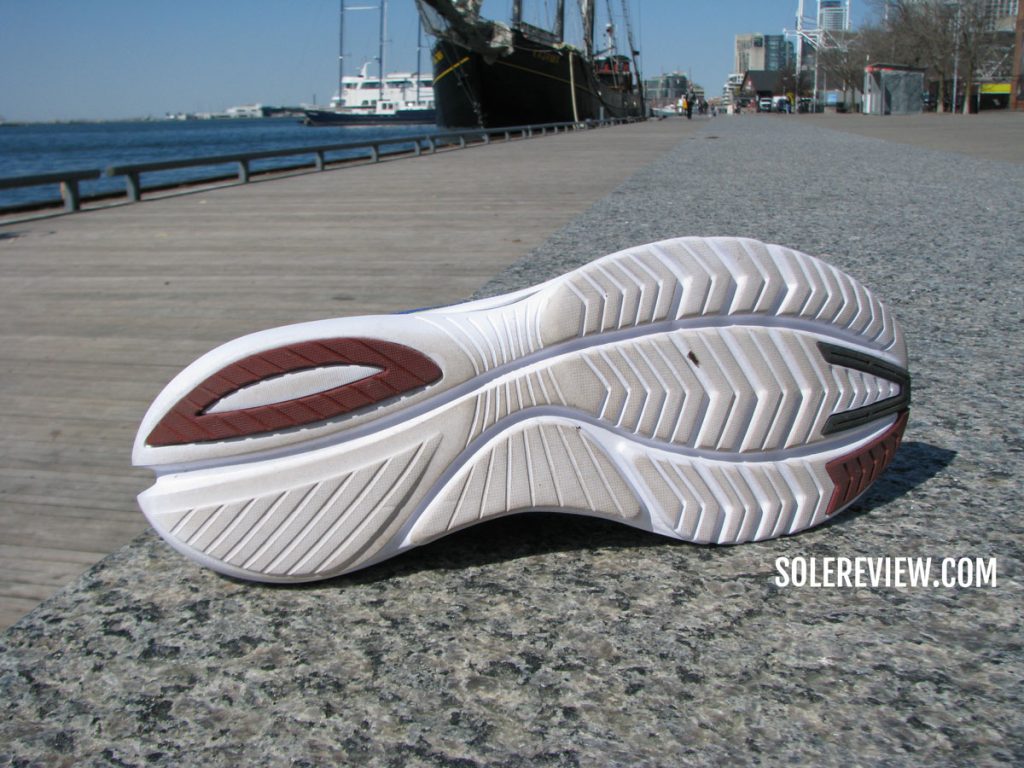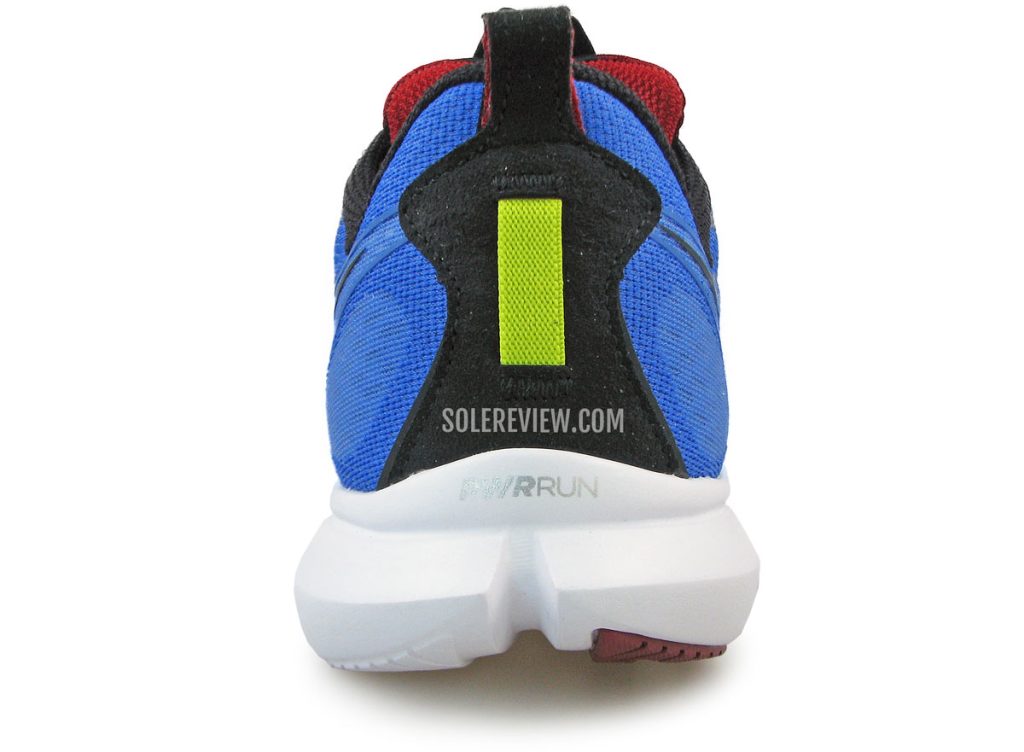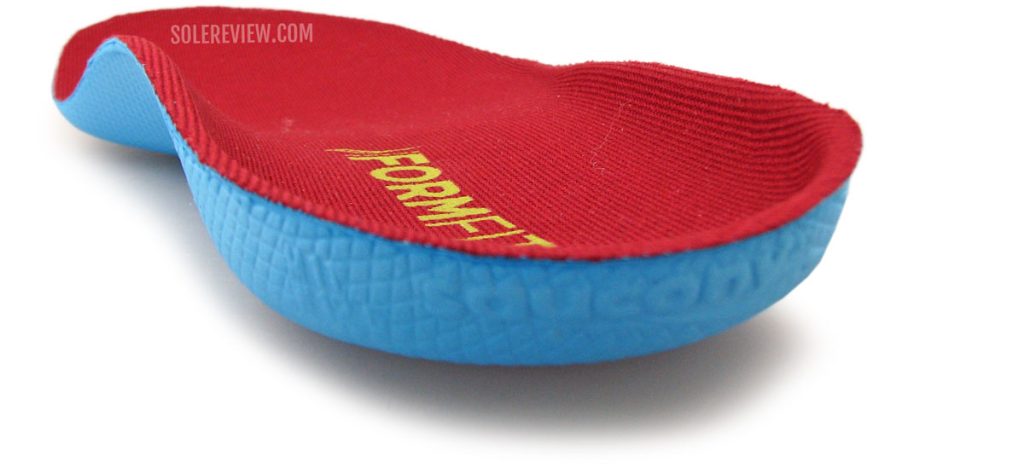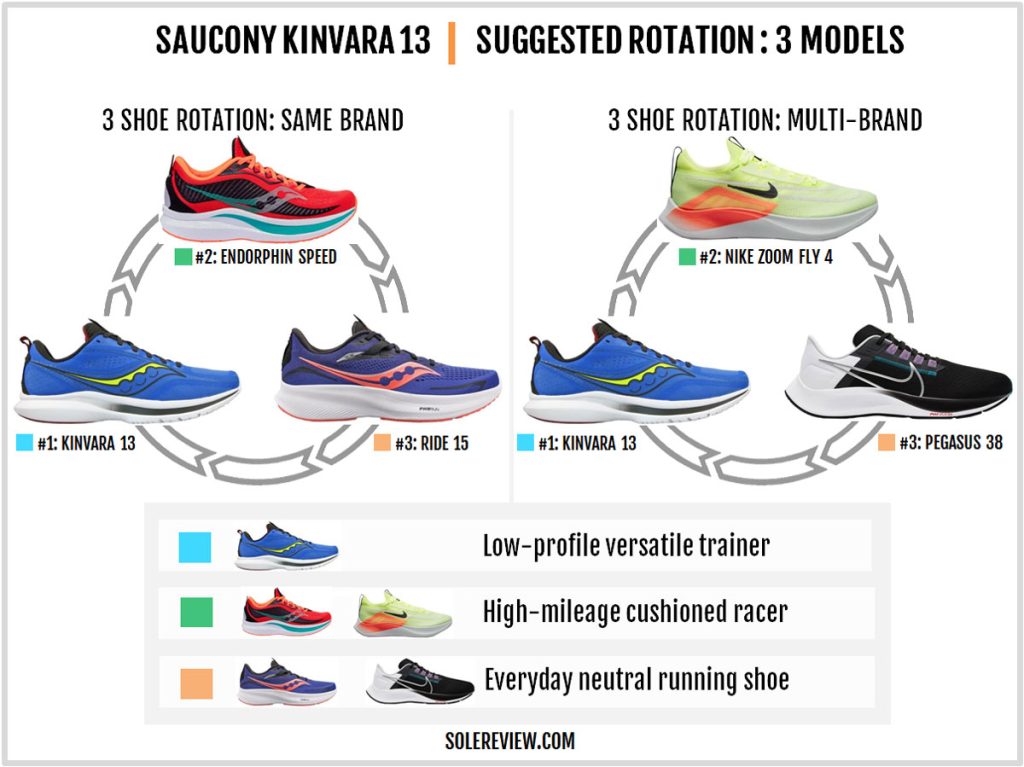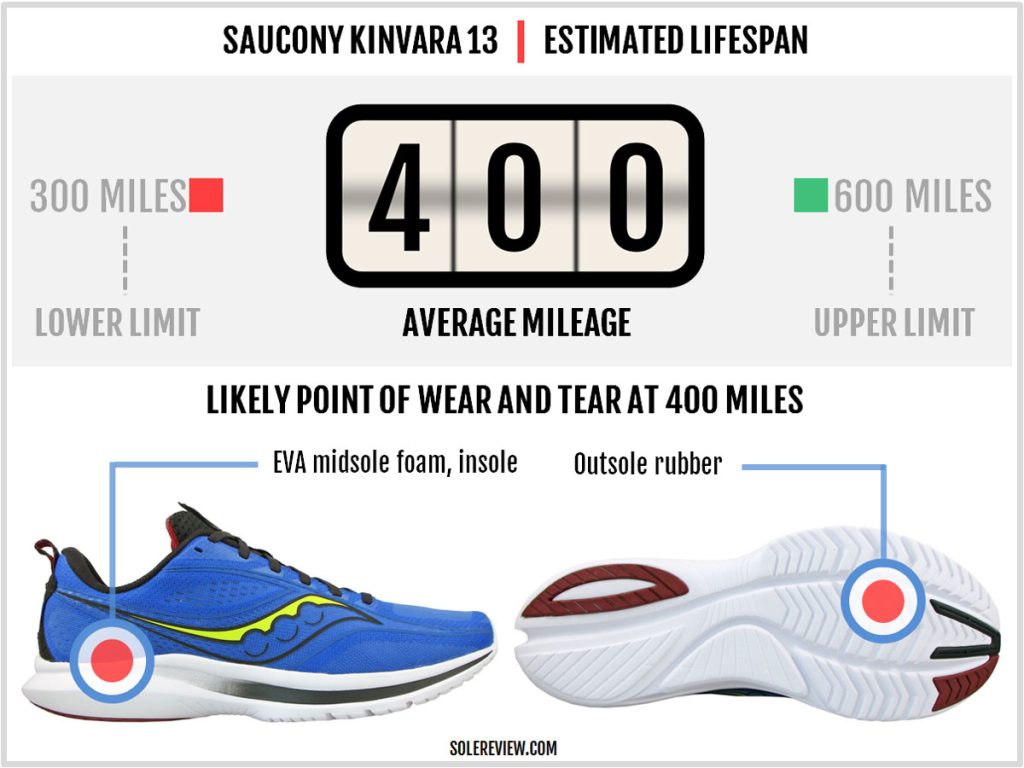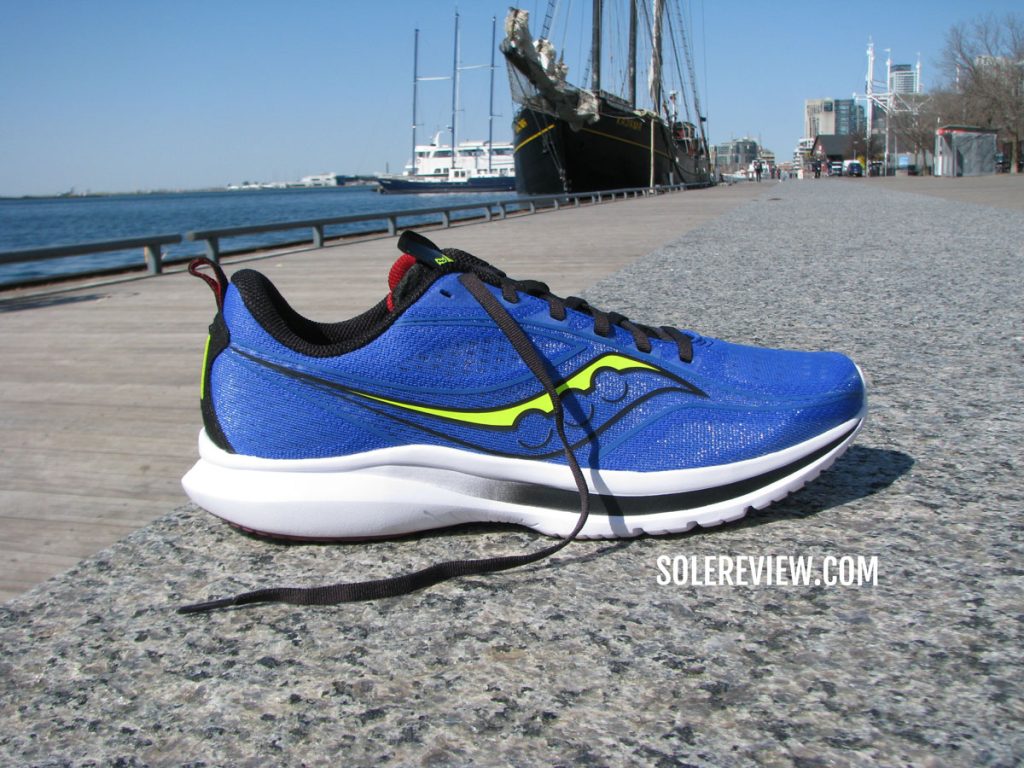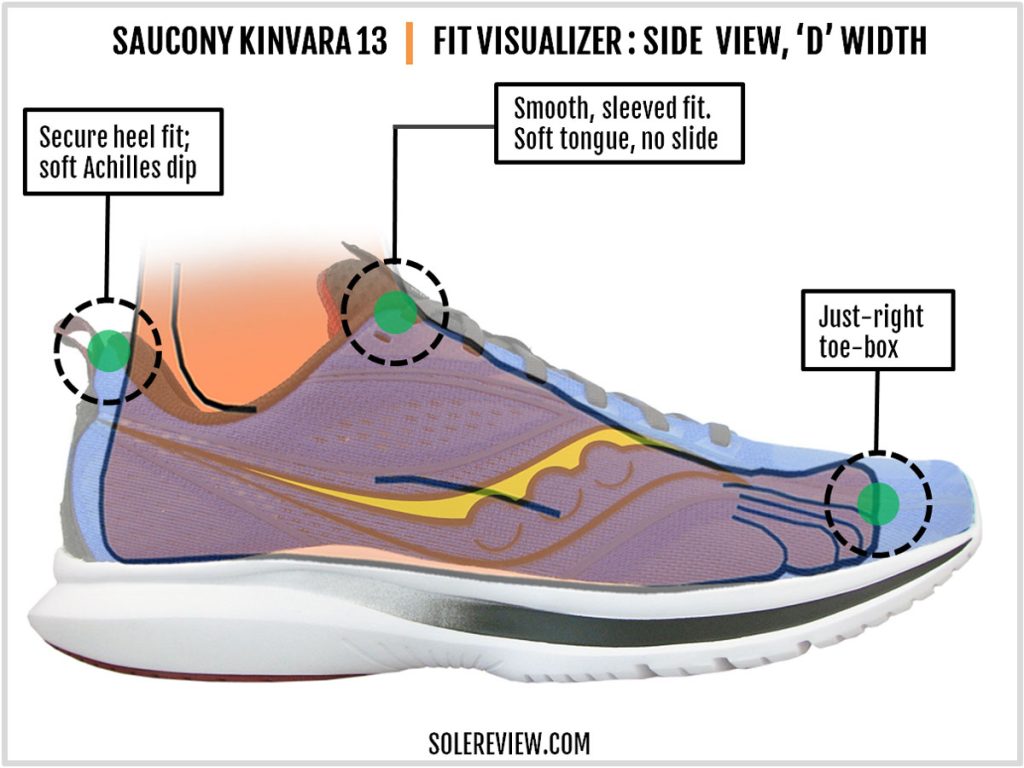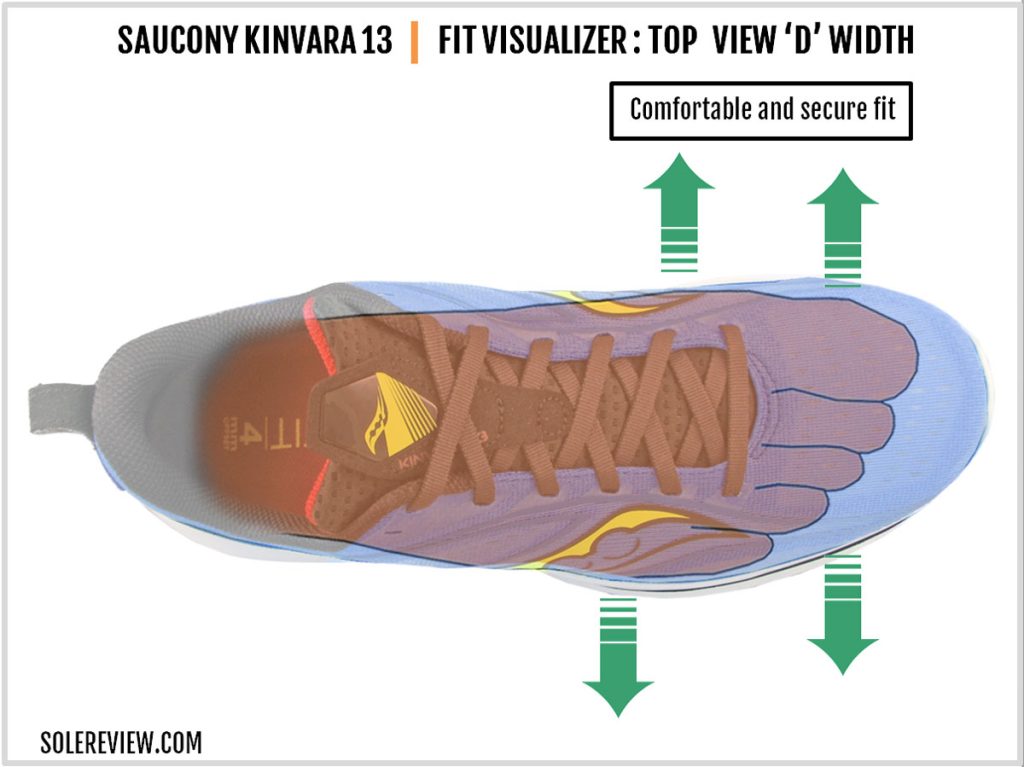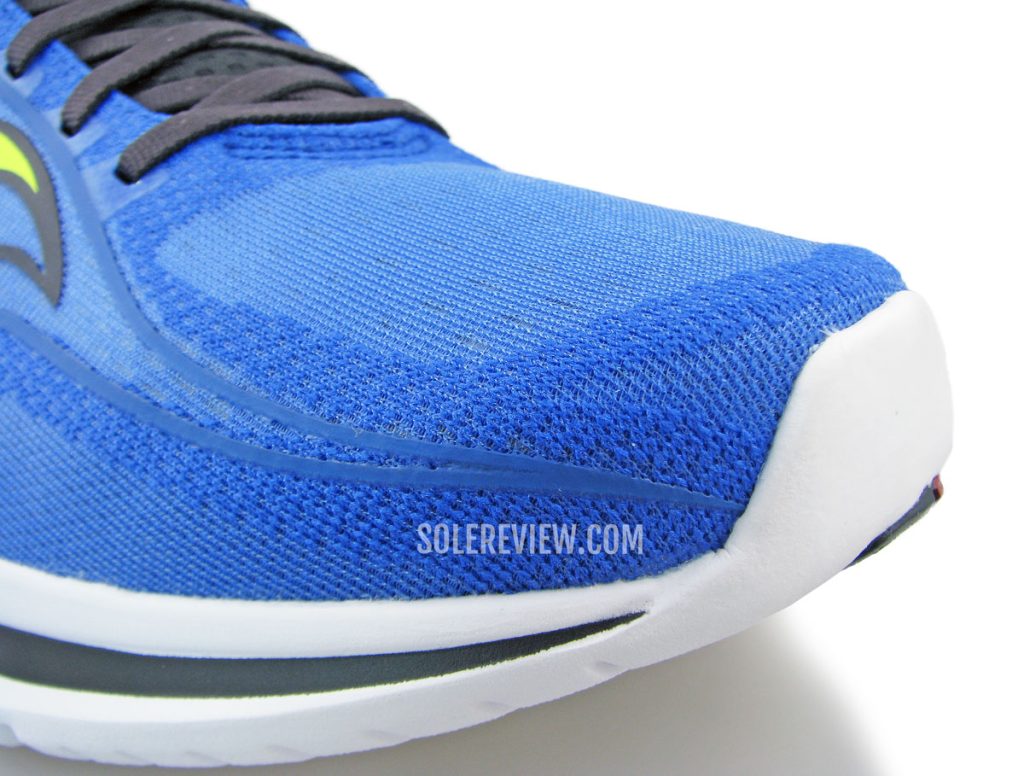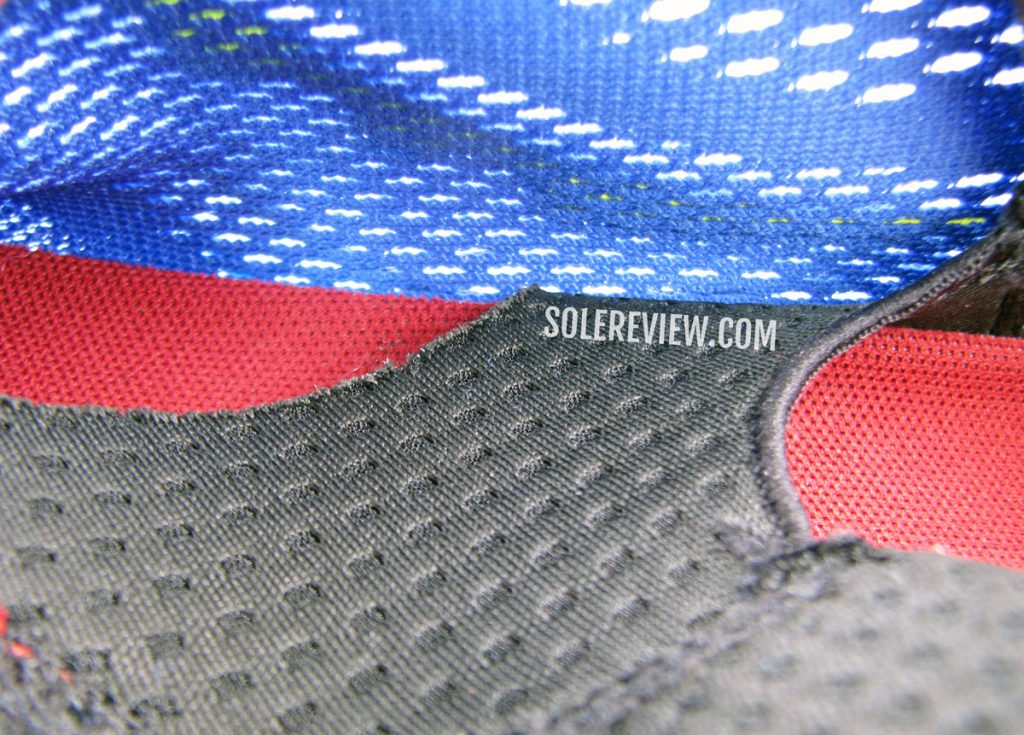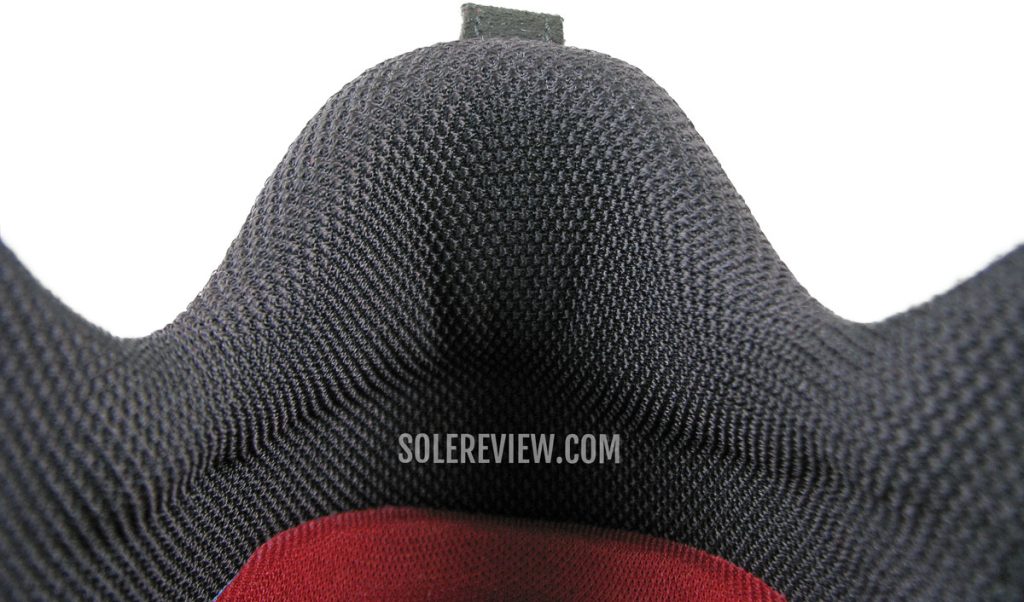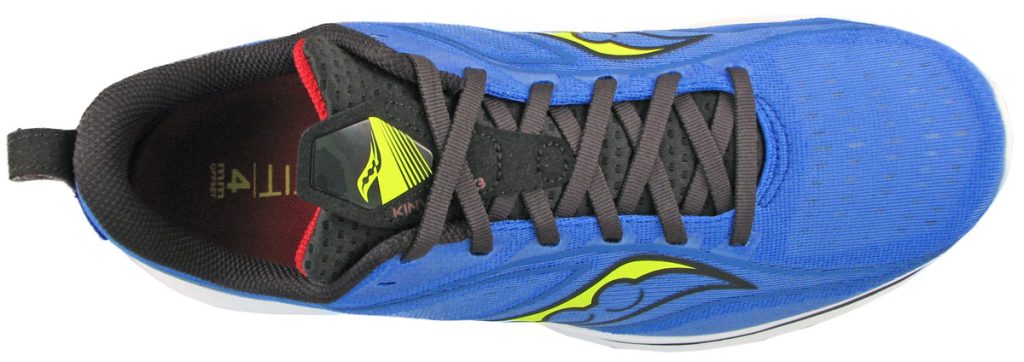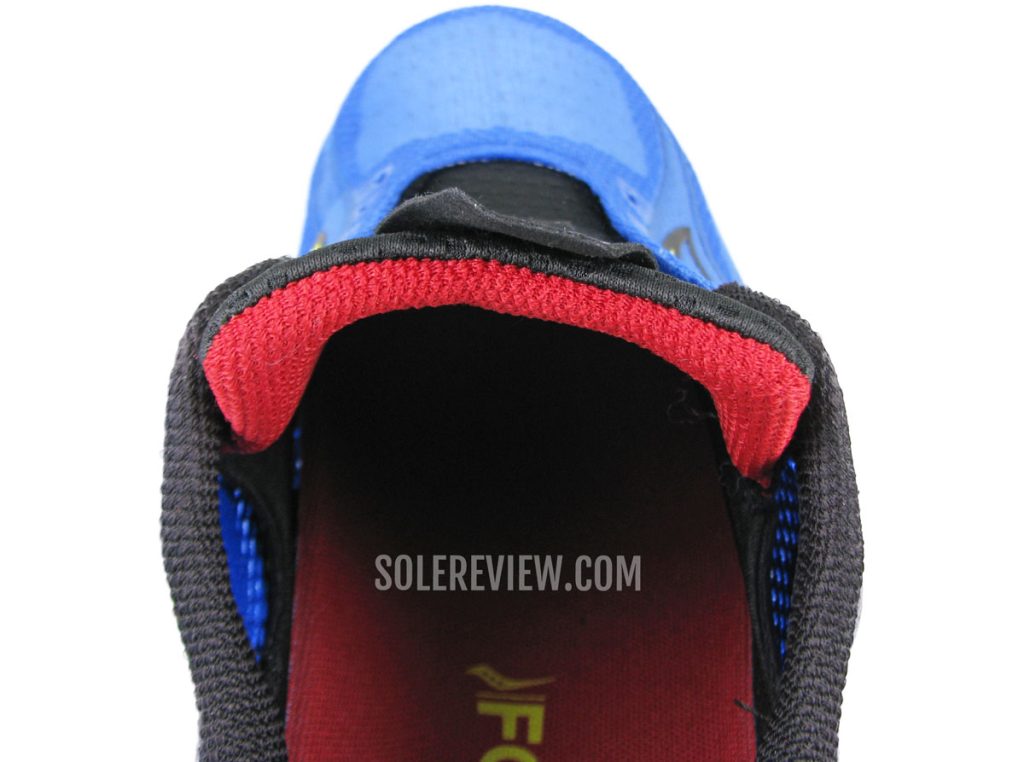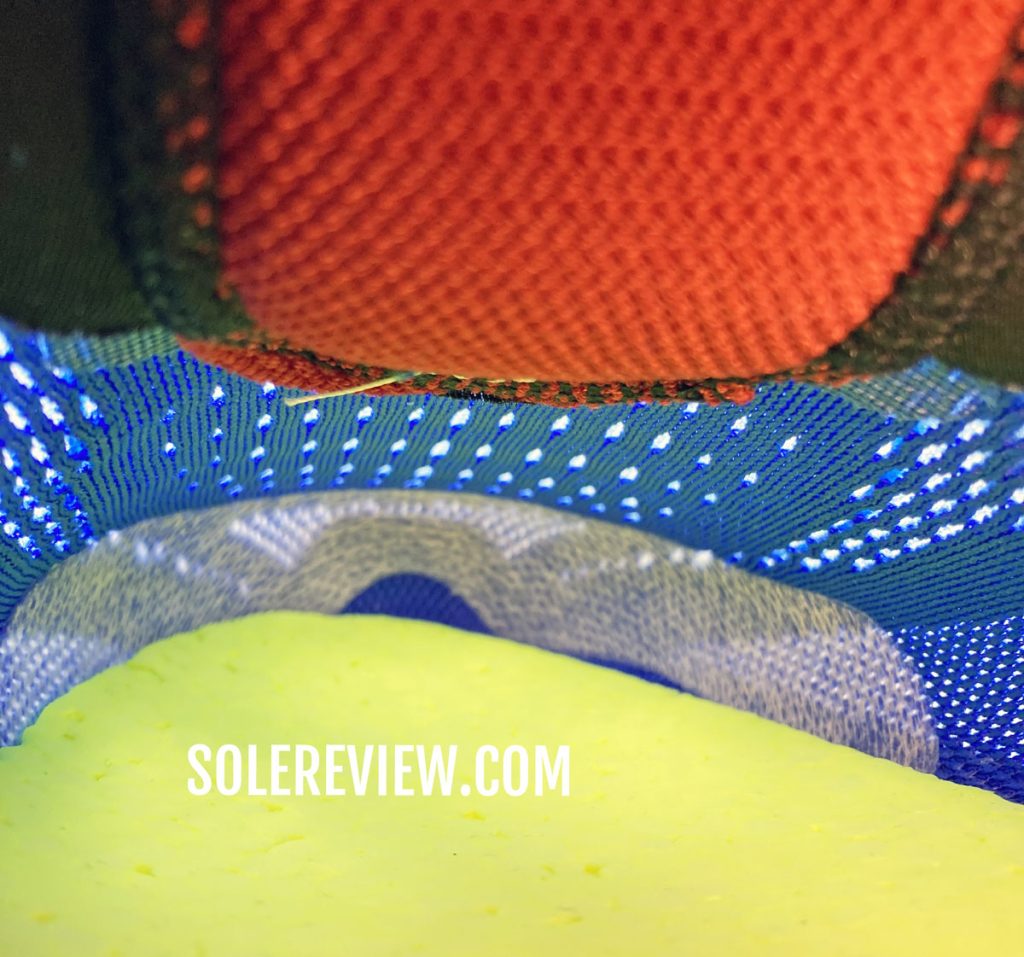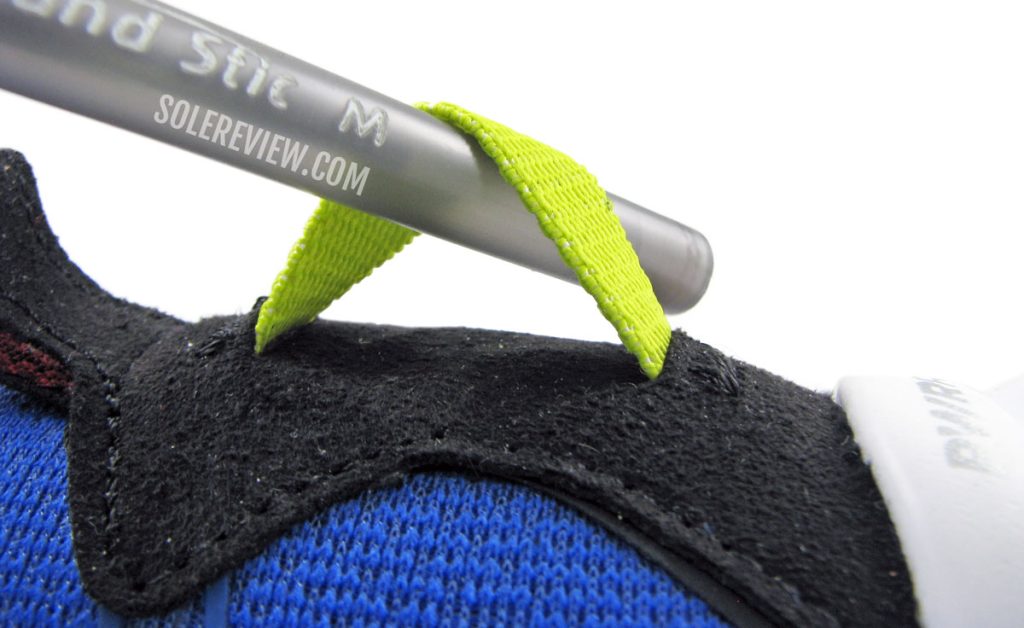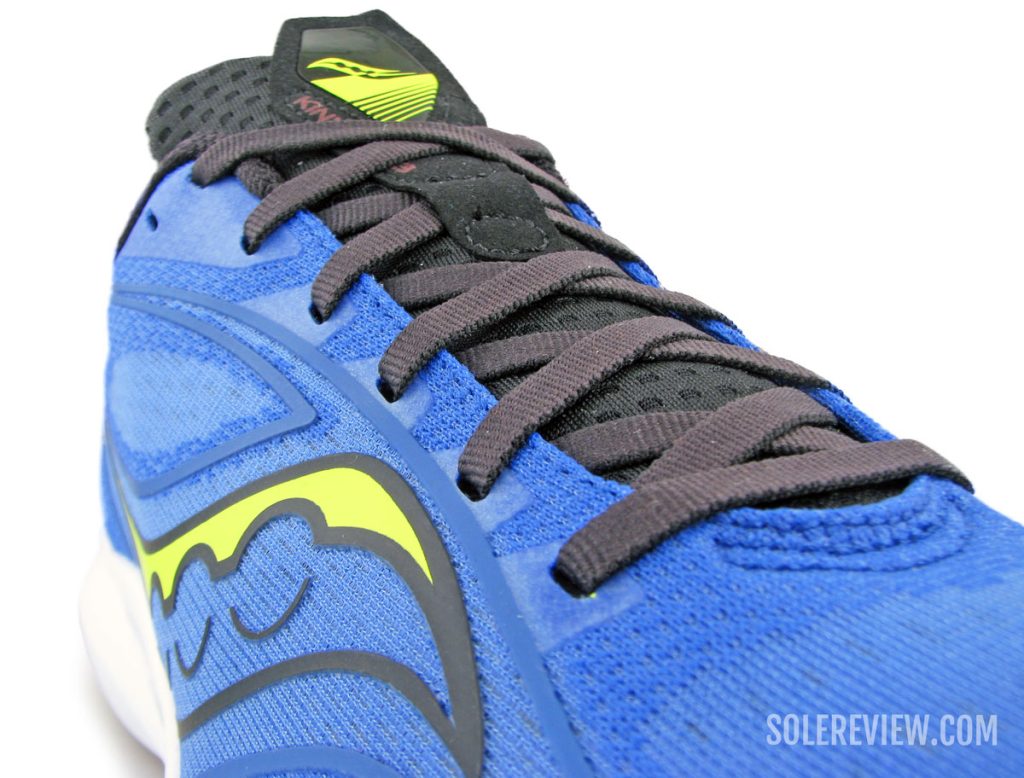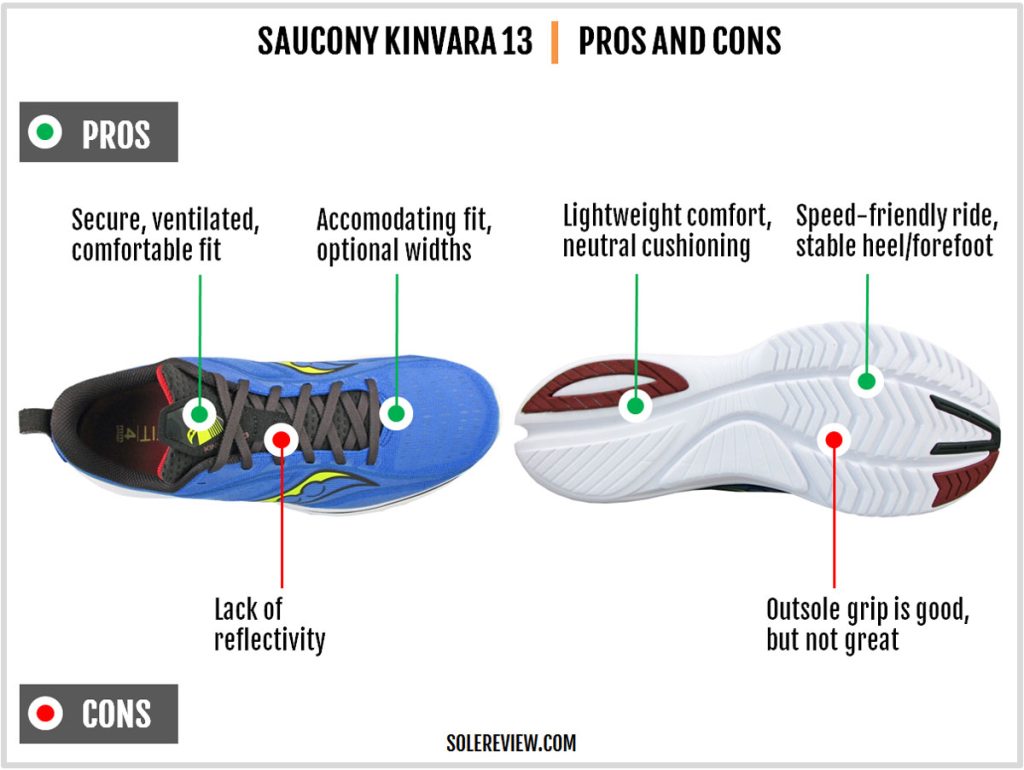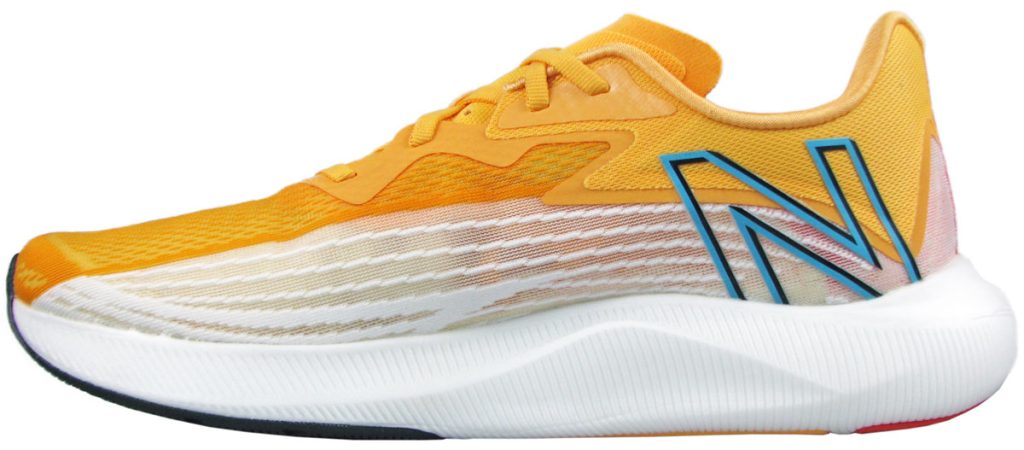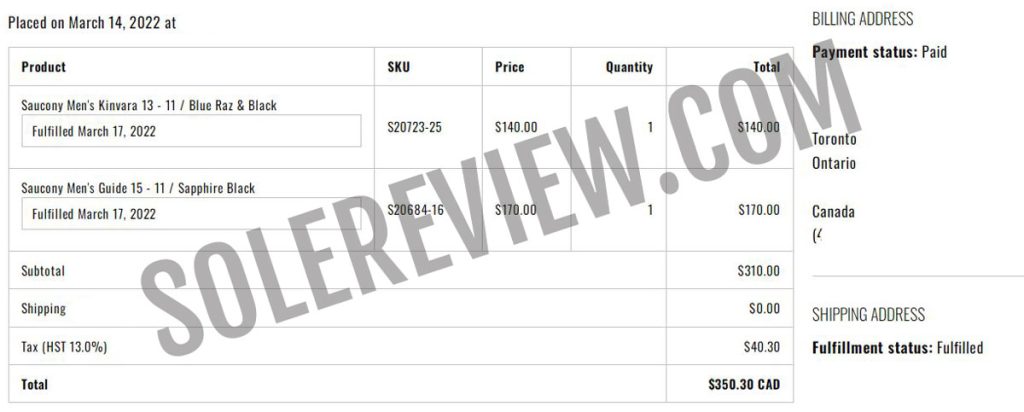
The Saucony Kinvara 13 was purchased at full retail price for our review. The amount is in Canadian Dollars.
In this review:
INTRODUCTION
Broadly speaking, two kinds of people read running shoe reviews.
The first group owns the current version of a shoe, and wants to know what has changed in the newest model.
This group has the usual set of questions. Does the new shoe have a redesigned midsole? What about the upper fit? Are there any ‘hidden’ updates? And more importantly, is the update better or worse than the old one? Or is the new shoe, for a lack of a better term, just different?
If you’re in this camp and wish to know what has changed on the Kinvara 13, the simple answer is – not a lot.
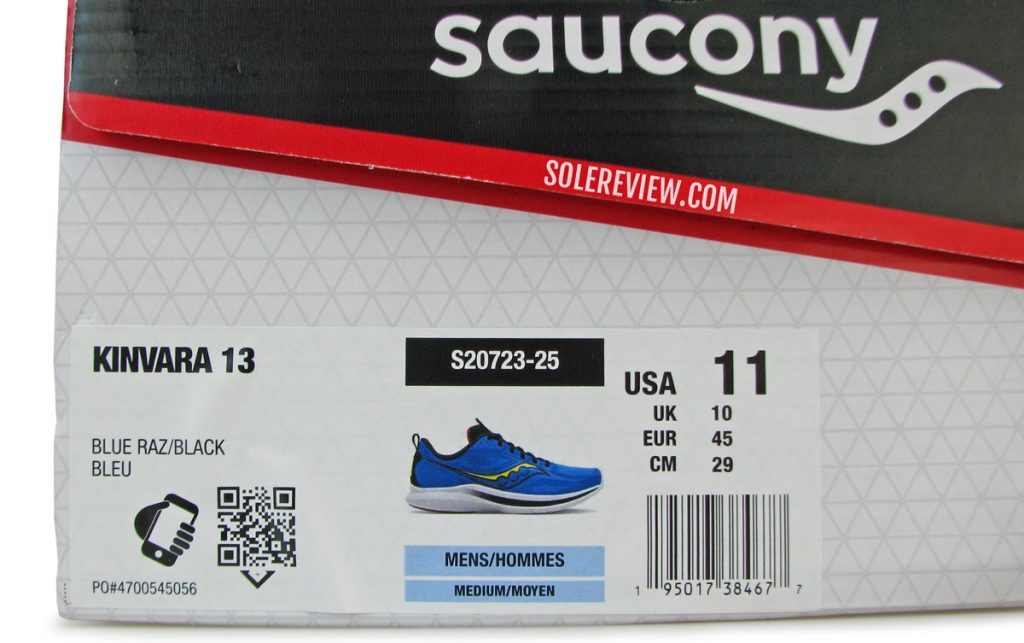
The Kinvara 13 is a mid-life refresh. Same midsole with a slightly modified upper. A lot of same-same.
This happens to a mid-cycle refresh, so that means that the 2022 Kinvara is based on the same midsole architecture as the Kinvara 12. Though there are changes on the upper, there’s only a marginal difference in the overall fit.
You may also want to know if the Kinvara 13 has the new Pwrrun+ (E-TPU) insole that’s used on the Ride 15, Guide 15, and Peregrine 12. Sadly, it does not.
Our guess is that the new insole also requires a brand new midsole. Since the Kinvara 13’s midsole hasn’t changed, we’ll have to wait for the 2023 update. By the way, did you know that Solereview maintains a calendar that tracks running shoe releases?
In short, the Kinvara 13 is virtually indistinguishable from the 12. So there’s no real reason to upgrade – unless you want to. You should also know that the 13 is $10 more expensive than the 12, so the older model (at a close-out deal) makes more economic sense.
The second group of readers are new to the Kinvara experience, and want to know what this shoe is about. If you happen to be that person, here’s a quick summary of the Kinvara.
The Saucony Kinvara 13 is a lightweight trainer with a firm ride.
Unlike most running shoes that have an 8 mm – 10 mm offset, the Kinvara has a low-profile midsole with a mere 4 mm difference between the heel and forefoot thickness.
This isn’t your everyday trainer with lots of ride comfort. However, it’s ideal when used as a part of a running shoe rotation. The firm and efficient ride makes it a good tool for speed and tempo training.
THE RIDE EXPERIENCE
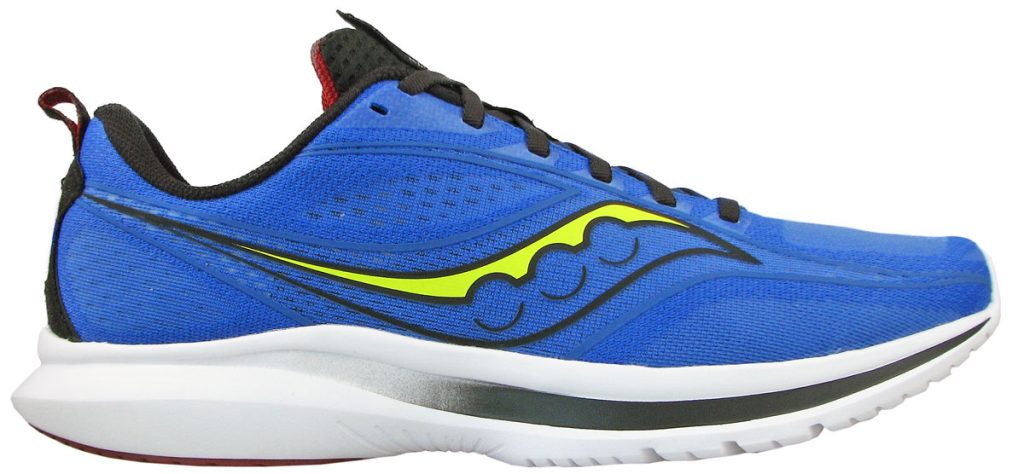
The Kinvara 13’s midsole isn’t complicated. It’s mostly a single density of foam with a couple of soft layers.
The Kinvara’s midsole dynamic has always been easy to read; there’s not a lot going on here. This is a mono-sole design, which means that the outsole is merely an afterthought.
Except for the tiny pieces of rubber under the high-wear zones, the outsole is an extension of the foam midsole. It’s the same as last year, so there are large chevron-shaped lugs under the forefoot for traction.
The grip is average on most foam-based outsoles, and it’s no different here – the traction is sufficient for dry and wet roads, but average on smooth floors and metal drainage covers.
This is a running shoe with a very firm ride – there are no ifs or buts. That has been the Kinvara’s calling card in its early days – even though there were a few years when the K-shoe turned soft.
In our Kinvara 12 review, we likened its minimal ride quality to the vintage Kinvara models.
Like the earliest models, the Kinvara 12 was a no-nonsense, lightweight trainer with a specific use case. Its firm ride made it an ideal candidate for runs of a slightly faster kind.
On days when the running pace exceeds 4:30 min/km or 7 min/mile, the low-profile ride proves to be a willing companion. The 7.2-ounce weight also contributes to the non-distracting ride character.
There’s also sufficient ride comfort – not ride softness though – for up to a half-marathon distance. The 28.5 mm heel and 24.5 mm forefoot stacks provide the necessary levels of cushioning protection that doesn’t punish the feet.
For high-mileage runs, we suggest a suitably-cushioned shoe. Later in this review, our rotational recommendation offers alternatives.
There’s a reason why we brought up the review of the last version. The V13’s chassis is the same as the 12, so nothing has changed from a ride viewpoint.
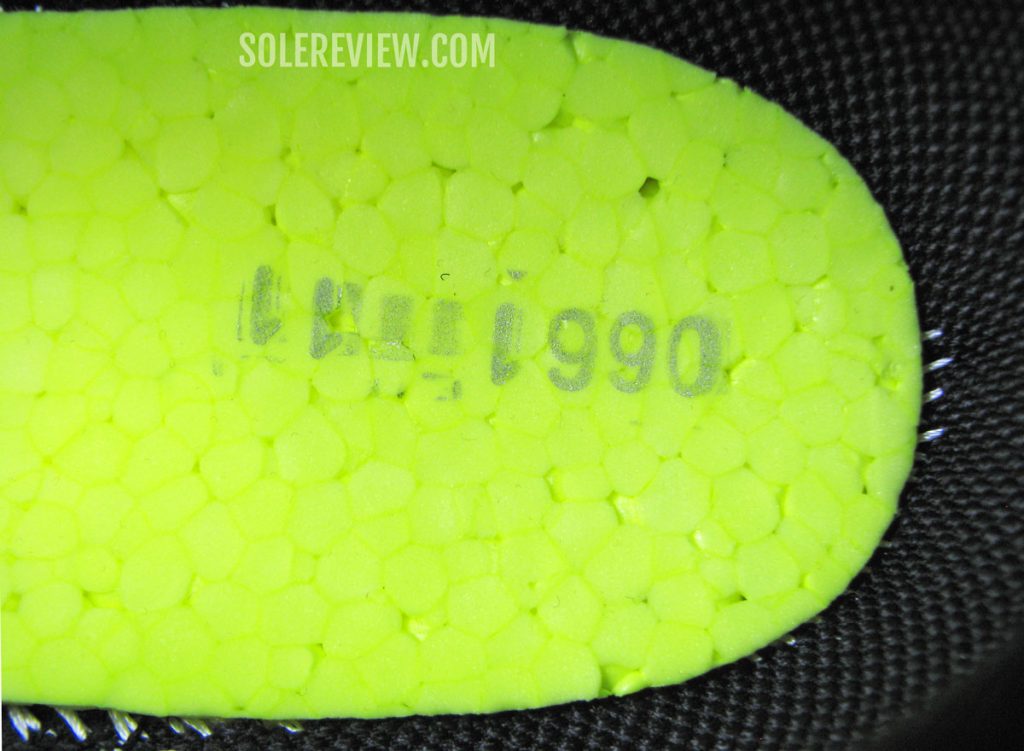
A Pwrrun+ topsole adds a layer of step-in softness. Unlike the Ride 15, the insole is still made of EVA foam.
Not even the insole has changed; the removable insole and Pwrrun+ (expanded PU) are the only layers of softness.
However, the step-in comfort doesn’t make the overall ride softer. If anything, the insole and topsole just waters down the harshness of the ultra-firm midsole.
The Pwrrun midsole is an EVA blend, so there’s a limited amount of responsiveness. In lieu, the firm foam stack provides plenty of ground feel that’s useful for quick touch-and-go transitions. There’s no sense of wasted effort here.
These days, most running shoes are expected to have some form of a transition-assistance feature like a plate or rocker-shaped midsole. The Kinvara 13 has nothing of that sort, and is as old school as it gets. Here, the human foot does most of the work.
The outsole has a lot of contact area, as well as a deep channel that functions as a transition groove.
Carving the longitudinal halves of the outsole leads to smoother weight-loading during the gait cycle. It doesn’t work in isolation, though. The firmness of the midsole helps with the process, and so does the 4 mm heel-to-toe offset.
Many other low-profile trainers have come and gone over the years. However, one of the reasons why the Kinvara has been around for over a decade is its consistency. A part of that consistency is a forefoot strike-friendly character.
It’s not just the 4 mm drop that makes the Kinvara suitable for forefoot and midfoot landing.
The heel is beveled without excess foam sticking out the back, and both the heel and forefoot have a flared base.
The wide foundation allows for a planted ride, no matter which section of the Kinvara is utilized. Needless to say, the ride is very stable and neutral without any bias.
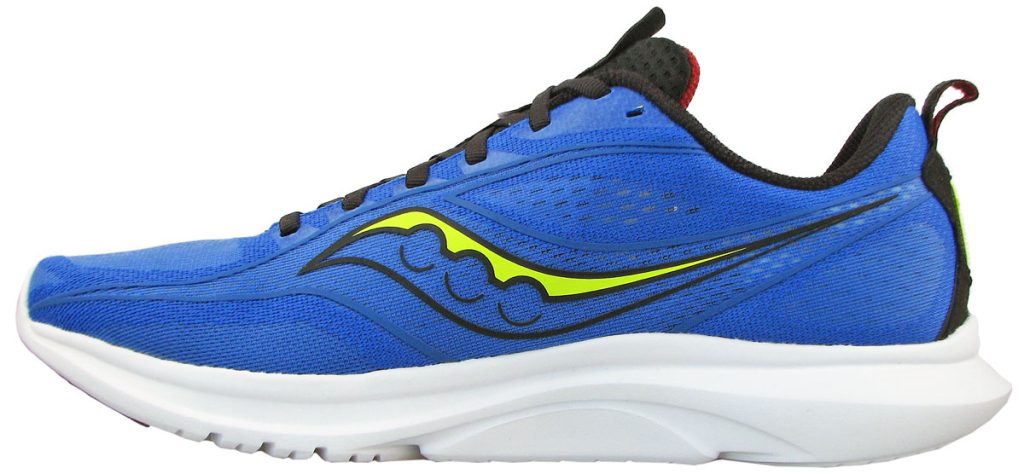
The area under the midfoot is supported with foam for smoother transitions and midfoot-strike compatibility.
The midfoot is well supported by the outsole design.
Instead of a narrow waist – like how many speed shoes have – the Kinvara’s midfoot is bridged with foam for stability. The flared insole also produces a comforting sensation of under-arch support.
RECOMMENDED ROTATION
Since the Kinvara 13 isn’t the ideal everyday trainer due to the minimal ride character, we recommend a shoe like the Saucony Ride 15 or Nike Pegasus 38 as your daily go-to shoes.
The Ride 15 has been completely redesigned for 2022, so there’s a higher level of ride comfort. Unlike the Kinvara, the Ride 15 also has the new insole made of expanded PU foam, or Pwrrun+. The Ride 15, along with the Nike Pegasus 38 are excellent candidates for everyday trainers.
Gone are the days when racing shoe choices were limited to barebones flats. Cushioned racers like the Saucony Endorphin Speed 2 and Nike Zoom Fly 4 work equally well for high-speed runs and long-distance runs.
Though both the shoes have generous amounts of cushioning, we recommend the Endorphin Speed over the Zoom Fly because of its superior PEBA foam midsole and lighter build.
IS THE SAUCONY KINVARA 13 DURABLE?
Even though the Kinvara lacks a proper rubber outsole, the firm density of the midsole foam makes it durable.
We have reviewed several avatars of the Kinvara for more than a decade, and the durability of the outsole has always been decent, if not great.
However, we don’t recommend off-road or trail use due to the lack of a protective rubber outsole. On a related note, the ‘Kinvara of the trail’ is the Saucony Peregrine 12. Here’s our review.
The upper materials and overall construction are similar to the past models, and none of them had concerns with low durability.
THE UPPER DESIGN AND FIT
Though we’ll be covering the finer aspects of the Kinvara 13’s upper construction and fit in this section, summing up the interior fit is easy.
Like the last model, the Kinvara 13 has a true-to-size fit with excellent proportions.
Everything feels just right; the toe-box has a wide profile, and the forefoot is secure yet comfortable. There’s an optional wide (2E) width available for the taking.
The midfoot has a secure grip, and so does the heel. The midfoot is partially sleeved, so the tongue doesn’t slide during runs.
That’s all you need to know about how the Kinvara 13 fits, really.
Between the Kinvara 12 and 13, we like the upper of the older version better. We say that for three reasons. The first is the absence of a full sleeve; the K-13 only uses a partial gusset.
For what it’s worth, the K-12’s fit was smoother. We also preferred the previous model’s tongue design. The flap edges were soft, and the synthetic suede overlay on top covered a larger area.
On the bright side, the ventilation has improved on the Kinvara 13. The forefoot and midfoot are generously vented for air circulation, and the broad toe-box profile helps too. There’s ample clearance on the top and sides of the toes, and that also plays a role in how breezy the shoe feels.
(Related read: The most breathable running shoes.)
The Kinvara 13 doesn’t have any reflectivity, and gets rid of whatever little low-visibility trims that the 12 had.
If you ask us, we think that Saucony is playing the Nike game. Which is, to sell a separate ‘Run Shield’ or ‘Vizi Pro’ assortment during the winter season for extra $$$.
There’s an elastic band over the heel, and it appears to be a cosmetic trim rather than serving any function.
The minor nit-picking aside, the Kinvara 13’s upper is excellent.
The partially stretchy laces are easy to cinch, and have the right length.
The heel is reinforced with a stiff internal counter for grip and stability. Even though it’s a full-sized counter, the low height doesn’t irritate the Achilles Tendon.
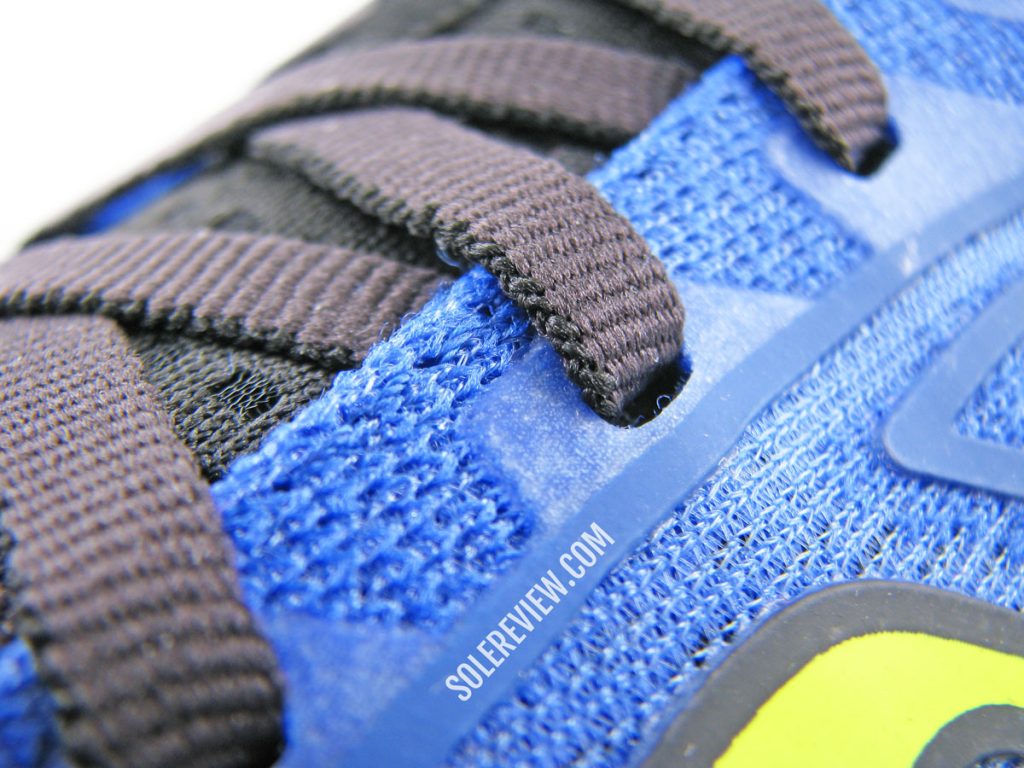
The invisible eyelets are reinforced with a backer. On the outside, fused layers provide structural support.
The outer shell is a giant single piece of mesh, so the insides feel seamless – because they are. Only the internal toe-bumper and high-density printing support the lightweight mesh upper.
PROS AND CONS
This graphic highlights most of the positive aspects of the Kinvara 13. Besides its speed-oriented road behavior, the firm cushioning is stable and forefoot-strike friendly.
The Kinvara 13 is not a racing flat, so there’s sufficient ride comfort for long-distance runs – say, up to a half marathon.
Except for the lack of reflectivity, the lightweight upper will make most runners happy. The breathable interiors fit true-to-size and use comfortable materials for a non-distracting fit experience.
As with all foam-based outsoles, the traction isn’t as great as rubber-clad running shoes.
SHOES SIMILAR TO THE SAUCONY KINVARA 13
There’s not much competition in the lightweight 4 mm offset trainer category, but if you’re willing to look past the heel drop, there are many alternatives to the Kinvara 13.
All the following running shoes blend a speed-friendly ride with cushioning comfort.
Even after taking into consideration the durability-related issues, the New Balance Fuelcell Rebel V2 (our review here) is one of our favorite speed trainers. It is incredibly cushioned and bouncy for its weight, and happens to be a suitable speed trainer that’s also very comfortable.
For a more traditional ride experience, there’s the New Balance Fresh Foam Tempo. (Our review here)
Though the Brooks Launch 9 has a higher heel-to-toe offset of 10 mm, it works both as a running shoe for forefoot strikers and tempo runs. The Launch 9 GTS is the same shoe, but with raised midsole sidewalls.
The adidas SL 20 3 gets lost in the shadow of the adizero pack, but it’s an under-rated performance running shoe with a penchant for speed runs.
Do you own this shoe? Improve this review by sharing your insights – submit a review here.

